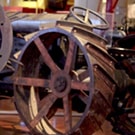Microscope Used by George Washington Carver, circa 1900
Add to SetSummary
By 1900, cotton production had depleted Southern soils, so George Washington Carver (1864-1943) developed nutritious crops like peanuts that nurtured the soil and could be sold to make industrial products. He used this microscope in his laboratory at the Tuskegee Institute in Alabama.
By 1900, cotton production had depleted Southern soils, so George Washington Carver (1864-1943) developed nutritious crops like peanuts that nurtured the soil and could be sold to make industrial products. He used this microscope in his laboratory at the Tuskegee Institute in Alabama.
Artifact
Microscope
Date Made
circa 1900

On Exhibit
at Henry Ford Museum in Agriculture
Object ID
97.6.1
Credit
From the Collections of The Henry Ford. Gift of Dr. Austin W. Curtis.
Material
Brass (Alloy)
Steel (Alloy)
Glass (Material)
Dimensions
Height: 10.75 in
Width: 5.75 in
Length: 4.25 in
Diameter: 2 in
Diameter: 1.125 in
Inscriptions
Eyepiece: B&L OPT. CO.,USA;5X base: BAUSCH & LOMB OPTICAL CO.; ROCHESTER, NY & NEW YORK CITY; 13462





